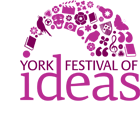Theme: Eoforwic: Anglian-era York
Eoforwic was the name for York during the four and a half centuries between Roman York and the Viking city. Learn more about this fascinating period of the city's history through poetry, talks, artefact handling, quizzes and more.
What's on
An Anglian Treasure: The Gilling Sword
A rare chance to hear the story of one of the star objects at the Yorkshire Museum, the Gilling Sword. Join York Museums Trust Curator Natalie McCaul to learn about the discovery of this amazing object. The event includes the chance to get hands on with this and other Anglian treasures from the museum’s collection.
Beadmaking in Anglo-Saxon Britain
Artisan historic beadmaker Mike Poole presents a display of handmade reproduction Anglo-Saxon glass beads at this drop-in event. Join Mike and find out about the making and significance of these colourful beads. Matched as closely as possible to the originals in terms of colour, shape and construction, the beads are based on research in museums and from archaeological reports.
The Reuse of Antiques in Anglo-Saxon England
Between 2005 and 2007, a large Anglo-Saxon cemetery was excavated at Street House, near Loftus in Cleveland. Archaeologist Stephen Sherlock discusses the significance of reused artefacts, mainly jewellery, found at the site. Some of these objects date back to prehistoric and Romano-British times, so were already antiques by the time they were buried around AD 650. Why were 250-year-old objects buried at Street House?
Beadmaking in Anglo-Saxon Britain
Artisan historic beadmaker Mike Poole presents a display of handmade reproduction Anglo-Saxon glass beads at this drop-in event. Join Mike and find out about the making and significance of these colourful beads. Matched as closely as possible to the originals in terms of colour, shape and construction, the beads are based on research in museums and from archaeological reports.
The Private Lives of the Saints
Explore the lives and times of some of the Early Medieval period’s best known, but least understood characters: the saints. Cuthbert, Bede, Brigit and Patrick are known for their sanctity, piety and place in heaven. However, they were also real people who walked the same terrains as we do and lived in buildings we can still make out today. Author Janina Ramirez unravels the private lives of these most public figures.
Beadmaking in Anglo-Saxon Britain
Artisan historic beadmaker Mike Poole presents a display of handmade reproduction Anglo-Saxon glass beads at this drop-in event. Join Mike and find out about the making and significance of these colourful beads. Matched as closely as possible to the originals in terms of colour, shape and construction, the beads are based on research in museums and from archaeological reports.
Countdown to Canute
Celebrate the 1000-year anniversary of Canute’s accession to the English throne with this Anglo-Saxon and Viking-themed general knowledge, words and numbers quiz. Join your host, a Viking skald, for kennings, mystery objects and more, including the deadly final round - Canute’s Conundrum. With mead and ale to buy from the bar, this light-hearted evening in the splendid Barley Hall is sure to appeal to your inner Viking!
Puzzles in the Pub
Just before the year 800, Alcuin sent Charlemagne a collection of mathematical puzzles which he said were to be solved for fun. The puzzles included problems dating back to Greek and Roman times which are still found in modern books of brain teasers. Join Rosalyn Leaman of the University of York and sharpen your wits over a glass of specially brewed Eoforwic Ale.
Anglian Kings and Coins
Learn more about the coinage of the Anglians and how they reflect turbulent times in York over 1,000 years ago. Join York Museums Trust Curator Andrew Woods as he introduces you to the Kings through their coinage.
Beer and Beowulf: The Conquest of Cnut
Welcome back to the Duke of York pub for our annual ‘Beer and Beowulf’ event. Come and join us to drink Eoforwic Ale - a beer brewed specially for the York Festival of Ideas from an old Anglo-Saxon recipe - and listen to Anglo-Saxon and Norse poetry commemorating the millennium of Cnut’s conquest of England in 1016.
Where There’s Muck, There’s Brass
Learn about the early Anglo-Saxon coinage of Northumbria produced in York in the 7th to 9th centuries. Archaeologist Tony Abramson explains its significance for understanding the increasing use of coinage, the balance of power, collection of taxes, differences between regions of the north, and settlement patterns. Find out why rather than a ‘Dark Age’, the Anglo-Saxon period was economically vibrant.

